- Calendar
- Online Ticket Sales
- Access
- JA
- EN
Special Exhibition
―Celebrating the Enthronement Ceremonies of His Majesty the Emperor
The Reproduction of Shosoin Treasures
Encountering Tenpyo Craftsmanship through the Recreation of 8th Century Works
January 26 to March 27, 2022
*Download the list of changes in works on display
*There will be an exhibition change during the course of exhibition.
*The period is subject to change.
The list of changes in worksPDF
1. Musical Instruments and Gigaku Masked Skits
The genesis of the Shosoin treasures lies in more than six hundred favorite personal items of Emperor Shomu (701–756; r. 724–749) that his consort Empress Komyo (701–760) dedicated to the Great Buddha of Todaiji. Of these, the “Red Sandalwood Five-String Biwa Lute” is particularly famous. It is thought to have been imported from China during the Tang dynasty (618–907), and it has a design in mother-of-pearl. The entire biwa is decorated using a range of techniques. In addition, its construction is significant as the only extant example of a five-string biwa of this type in the world. The Office of the Shosoin Treasure House spent eight years on the reproduction work, ultimately achieving an instrument that not only used the same materials and exquisite artistry as the original treasure, but that could actually play music as well.
The Shosoin also contains a great number of items related to the consecration ceremonies for the Great Buddha that took place in 752 (Tenpyo Shoho 4) at Todaiji. Of note are the masks used in gigaku performances enacted during these ceremonies. The humorous appearance of the masks and the colorful costumes of these skits originating in southern China provide a glimpse of the cosmopolitan taste of the era.
Please enjoy the quintessence of Tenpyo times vividly reborn in these recreations of musical instruments and gigaku materials.
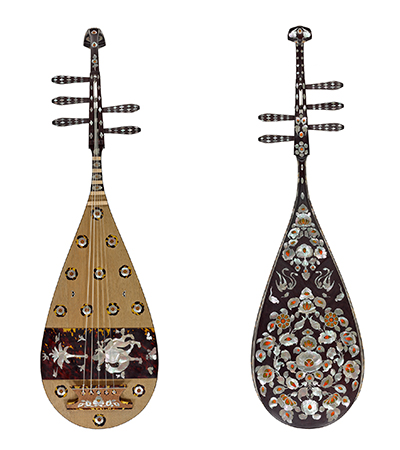
By Sakamoto Kyokusai III, woodwork; Nitta Kiun, inlay; Kitamura Shosai and Matsuura Naoko, decoration;
and Marusan Hashimoto Co., strings
2011‒2018 (Heisei 23-30)
Office of the Shosoin Treasure House, Imperial Household Agency
【To be shown over an entire period】
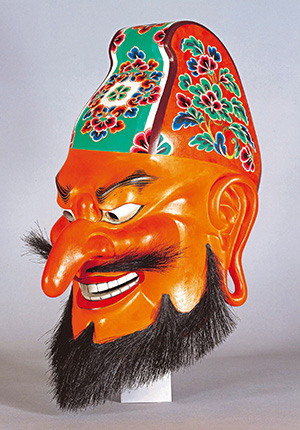
By Bijutsuin National Treasure Restoration Center
2002-2003 (Heisei 14-15)
Office of the Shosoin Treasure House, Imperial Household Agency
【To be shown over an entire period】
2. Buddhist and Ceremonial Ritual Implements, Offering Boxes, Tables, and Stands
Society during the Nara period (710-794) was governed through a national criminal and administrative law system (ritsu ryo) that had its center in the Heijo captial. Buddhism came to the forefront at this time, supporting Heijo by offering a means of praying for stability, order, and continued peace in the nation. Such developments lie behind numerous Buddhist implements, offering boxes and tables, as well as ritual tools, preserved in the Shosoin. These objects evoke the eighth-century forms of prayer offered before Buddhist images, ceremonies, and palace rituals.
The treasures of this section were made using materials ranging from wood to bamboo, clay, and metal. They were then beautifully decorated with various techniques like painting, marquetry, and incised drawings in stained ivory (bachiru), techniques deployed in alignment with the religious functions of each respective treasure. Minute inspection and detailed research were essential to the reproduction of these richly conceived treasures. Many aspects were extremely difficult to faithfully reproduce, such as the subtle colors and flow of the ceramic glazes or the thin, finely shaved bodies of the metal bowls; yet, as is readily apparent, amazing reproductions have been brought to fruition through the excellent techniques of master artisans.
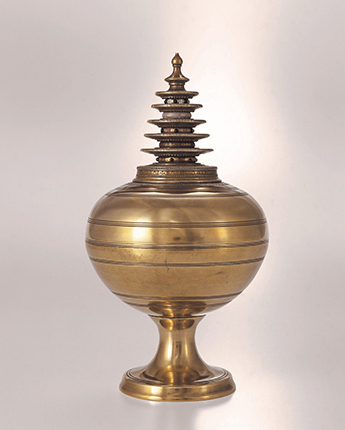
By Hannya Kankei, casting; and Urashima Shisei, engraving
2004 (Heisei 16)
Office of the Shosoin Treasure House, Imperial Household Agency
【To be shown over an entire period】
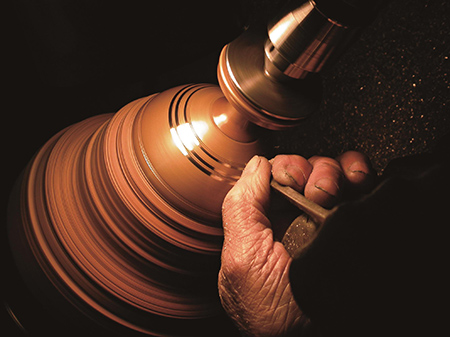
3. Textiles
The connection between the imperial household and sericulture is an ancient one, as evidenced by a poem in the Man'yōshū where Empress Regnant Koken (718-770, r. 749-758 as Koken, 764-770 as Shotoku) prays for an abundant cocoon harvest. During the Nara period (710-794), silkworms were cultivated throughout the country.
Over five thousand textiles are preserved in the Shosoin. These include silk textiles with a wide range of weave structures. Ashiginu are unpatterned, plain-weave silks where single warp and weft threads alternate passing under and over each other. Twill damasks (aya) have diagonal warp-weft intersections forming a background that contrasts with another weave structure to create a design pattern. Complex gauze weaves (ra) are thin fabrics constructed like a net by crossing neighboring warp threads to the left and right. Nishiki are multi-colored textiles using threads of various colors to weave a pattern. The textiles selected for reproduction were chosen from those with a clear provenance, those incorporated into numerous treasures, and those with prominent distinguishing characteristics. Serious consideration was also given to the types of dyes used. Yet the radius of the cross-section of ancient silk filaments was only two-thirds to one-half that of silk filament generally used today. For the reproductions, silk from the imperial palace was used, because the koishimaru cocoons cultivated there since the Meiji era (1868-1912) had the qualities close to the Nara-period threads.
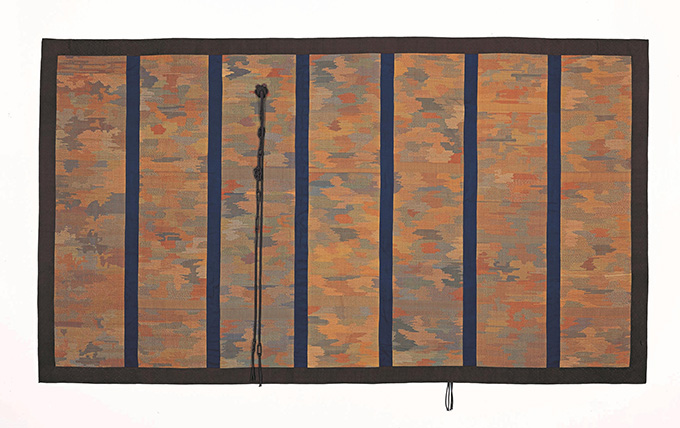
By Tatsumura Textile Co., Ltd.
2007 -2009 (Heisei 19-21)
Office of the Shosoin Treasure House, Imperial Household Agency
【To be shown over an entire period】
4. Mirrors, Furnishings, and Accessories
The furnishings and accessories in the section are important artifacts relating the customs and elegant lifestyles of aristocrats during the Nara period (710-794) and the Tang dynasty (618-907) in China. Dazzling jeweled mirrors, a cabinet in which Emperor Shomu (701-756; r. 724-749) and his consort Empress Komyo (701-760) kept various items, games and their accessories brought from the Asian continent, a belt studded with precious lapis lazuli stones acquired through East-West trade, and, looped around this belt, penknives attached to the body—all these display to the fullest the outstanding technical expertise of artisans during this period. They also transmit to the present something of the richly cosmopolitan Tenpyo culture.
Although the circumstances behind their production and the techniques by which they were made differed over time, the Shosoin treasures have all been reproduced faithfully in their forms and designs, as much as possible using lost techniques. The results have been brought to bear on later conservation and reproduction projects, ensuring the continuation of the artistic techniques they represent.
The creation of reproductions has not only revived the spirit of Tenpyo times embodied in magnificent works; it also inspires future innovation in Japanese arts.
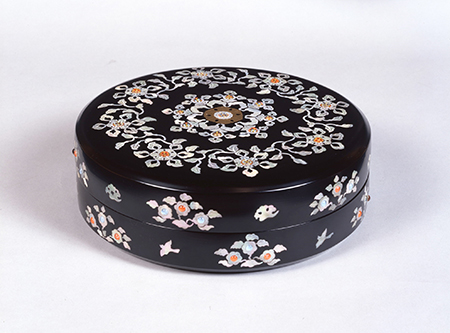
By Kawakita Ryozo, woodwork; Kitamura Taitsu, lacquerwork and decoration; and Takata Yoshio, textile lining
1976-1977, 1979 (Showa 57-52,54)
Office of the Shosoin Treasure House, Imperial Household Agency
【To be shown over an entire period】
5. Swords and Military Equipment
From ancient times, the Shosoin served as a storehouse for swords and military equipment. The Record of the Nation's Rare Treasures (Kokka chinpo cho) lists the donation of numerous weapons, including one hundred tachi swords. In 764 (Tenpyo Hoji 8), however, the majority of these were taken out of the Repository during the rebellion of Fujiwara no Nakamaro (706-764) and not returned. The three that remained included the "Decorative Karatachi-Style Sword with Gold, Silver, and Glass Decoration" and the "Stick Sword with Kuretake Bamboo Sheath" in the North Section of the Repository. These were beautifully ornamented personal belongings of Emperor Shomu (701-756; r. 724-749) that were possibly used for ceremonies. Because of the authenticity of their provenance and the excellence of their craftsmanship, these swords were reproduced several times during the Meiji era (1868-1912).
Apparently, to replace the unreturned weapons, military equipment from Todaiji was moved to the Shosoin. Among the fifty-five swords transmitted in the Middle Section of the Shosoin, in addition to swords for ceremonial use, one can identify numerous fighting swords for practical use. Over 3,800 arrows have been passed down, and though they have lost their arrow feathers, during the Meiji era they were reproduced in their original form. Gorgeous ornamentation of the military equipment goes without saying; please note as well the functional beauty of these articles made to be used.

Meiji era,19th century
Office of the Shosoin Treasure House, Imperial Household Agency
【To be shown over an entire period】
6. Documents, Brushes, and Ink
Administrative offices in the Nara period (710-794) operated through written records. Concrete evidence is seen in the almost 660 handscrolls transmitted as Shosoin documents. The collection of records from the Todaiji scriptorium makes up the core of these Shosoin documents. Frequently, such records are on the other sides of papers that were no longer needed elsewhere, resulting in the preservation of numerous documents of a wide variety.
The tax account books reporting provincial finances and household names were first submitted to the central ministry offices. Although these had no direct connection with Todaiji., after the requisite storage period had elapsed, the central ministry passed them on so their reverse side could be reused at the scriptorium, where they were handed down. Preserved among these scriptorium records are administrative records and requests for days off that illuminate the circumstances surrounding the life and work of people at that time.
To reproduce the Shosoin documents, facsimiles have been made using collotype printing. Collotype printing is an amazing technique that creates facsimiles of a higher quality and greater permanance than those produced through offset printing. We hope you observe something of what this printing technique can do in the refined replications found in this section.
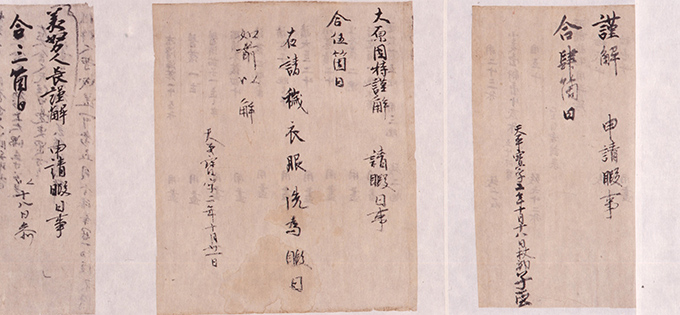
By National Museum of Japanese History
1987 (Showa 62)
【To be shown over an entire period】
*Unauthorized reproduction or use of texts or images from this site is prohibited.
2025 January
- Exhibition
- Closed
- Tea Ceremony
- Mon
- Tue
- Wed
- Thu
- Fri
- Sat
- Sun
- 1
- 2
- 3
- 4
- 5
- 6
- 7
- 8
- 9
- 10
- 11
- 12
- 13
- 14
- 15
- 16
- 17
- 18
- 19
- 20
- 21
- 22
- 23
- 24
- 25
- 26
- 27
- 28
- 29
- 30
- 31
2025 February
- Exhibition
- Closed
- Tea Ceremony
- Mon
- Tue
- Wed
- Thu
- Fri
- Sat
- Sun
- 1
- 2
- 3
- 4
- 5
- 6
- 7
- 8
- 9
- 10
- 11
- 12
- 13
- 14
- 15
- 16
- 17
- 18
- 19
- 20
- 21
- 22
- 23
- 24
- 25
- 26
- 27
- 28
2025 March
- Exhibition
- Closed
- Tea Ceremony
- Mon
- Tue
- Wed
- Thu
- Fri
- Sat
- Sun
- 1
- 2
- 3
- 4
- 5
- 6
- 7
- 8
- 9
- 10
- 11
- 12
- 13
- 14
- 15
- 16
- 17
- 18
- 19
- 20
- 21
- 22
- 23
- 24
- 25
- 26
- 27
- 28
- 29
- 30
- 31
2025 April
- Exhibition
- Closed
- Tea Ceremony
- Mon
- Tue
- Wed
- Thu
- Fri
- Sat
- Sun
- 1
- 2
- 3
- 4
- 5
- 6
- 7
- 8
- 9
- 10
- 11
- 12
- 13
- 14
- 15
- 16
- 17
- 18
- 19
- 20
- 21
- 22
- 23
- 24
- 25
- 26
- 27
- 28
- 29
- 30
2025 May
- Exhibition
- Closed
- Tea Ceremony
- Mon
- Tue
- Wed
- Thu
- Fri
- Sat
- Sun
- 1
- 2
- 3
- 4
- 5
- 6
- 7
- 8
- 9
- 10
- 11
- 12
- 13
- 14
- 15
- 16
- 17
- 18
- 19
- 20
- 21
- 22
- 23
- 24
- 25
- 26
- 27
- 28
- 29
- 30
- 31
2025 June
- Exhibition
- Closed
- Tea Ceremony
- Mon
- Tue
- Wed
- Thu
- Fri
- Sat
- Sun
- 1
- 2
- 3
- 4
- 5
- 6
- 7
- 8
- 9
- 10
- 11
- 12
- 13
- 14
- 15
- 16
- 17
- 18
- 19
- 20
- 21
- 22
- 23
- 24
- 25
- 26
- 27
- 28
- 29
- 30
2025 July
- Exhibition
- Closed
- Tea Ceremony
- Mon
- Tue
- Wed
- Thu
- Fri
- Sat
- Sun
- 1
- 2
- 3
- 4
- 5
- 6
- 7
- 8
- 9
- 10
- 11
- 12
- 13
- 14
- 15
- 16
- 17
- 18
- 19
- 20
- 21
- 22
- 23
- 24
- 25
- 26
- 27
- 28
- 29
- 30
- 31
2025 August
- Exhibition
- Closed
- Tea Ceremony
- Mon
- Tue
- Wed
- Thu
- Fri
- Sat
- Sun
- 1
- 2
- 3
- 4
- 5
- 6
- 7
- 8
- 9
- 10
- 11
- 12
- 13
- 14
- 15
- 16
- 17
- 18
- 19
- 20
- 21
- 22
- 23
- 24
- 25
- 26
- 27
- 28
- 29
- 30
- 31
2025 September
- Exhibition
- Closed
- Tea Ceremony
- Mon
- Tue
- Wed
- Thu
- Fri
- Sat
- Sun
- 1
- 2
- 3
- 4
- 5
- 6
- 7
- 8
- 9
- 10
- 11
- 12
- 13
- 14
- 15
- 16
- 17
- 18
- 19
- 20
- 21
- 22
- 23
- 24
- 25
- 26
- 27
- 28
- 29
- 30
2025 October
- Exhibition
- Closed
- Tea Ceremony
- Mon
- Tue
- Wed
- Thu
- Fri
- Sat
- Sun
- 1
- 2
- 3
- 4
- 5
- 6
- 7
- 8
- 9
- 10
- 11
- 12
- 13
- 14
- 15
- 16
- 17
- 18
- 19
- 20
- 21
- 22
- 23
- 24
- 25
- 26
- 27
- 28
- 29
- 30
- 31
2025 November
- Exhibition
- Closed
- Tea Ceremony
- Mon
- Tue
- Wed
- Thu
- Fri
- Sat
- Sun
- 1
- 2
- 3
- 4
- 5
- 6
- 7
- 8
- 9
- 10
- 11
- 12
- 13
- 14
- 15
- 16
- 17
- 18
- 19
- 20
- 21
- 22
- 23
- 24
- 25
- 26
- 27
- 28
- 29
- 30
2025 December
- Exhibition
- Closed
- Tea Ceremony
- Mon
- Tue
- Wed
- Thu
- Fri
- Sat
- Sun
- 1
- 2
- 3
- 4
- 5
- 6
- 7
- 8
- 9
- 10
- 11
- 12
- 13
- 14
- 15
- 16
- 17
- 18
- 19
- 20
- 21
- 22
- 23
- 24
- 25
- 26
- 27
- 28
- 29
- 30
- 31
2026 January
- Exhibition
- Closed
- Tea Ceremony
- Mon
- Tue
- Wed
- Thu
- Fri
- Sat
- Sun
- 1
- 2
- 3
- 4
- 5
- 6
- 7
- 8
- 9
- 10
- 11
- 12
- 13
- 14
- 15
- 16
- 17
- 18
- 19
- 20
- 21
- 22
- 23
- 24
- 25
- 26
- 27
- 28
- 29
- 30
- 31
2026 February
- Exhibition
- Closed
- Mon
- Tue
- Wed
- Thu
- Fri
- Sat
- Sun
- 1
- 2
- 3
- 4
- 5
- 6
- 7
- 8
- 9
- 10
- 11
- 12
- 13
- 14
- 15
- 16
- 17
- 18
- 19
- 20
- 21
- 22
- 23
- 24
- 25
- 26
- 27
- 28
2026 March
- Exhibition
- Closed
- Mon
- Tue
- Wed
- Thu
- Fri
- Sat
- Sun
- 1
- 2
- 3
- 4
- 5
- 6
- 7
- 8
- 9
- 10
- 11
- 12
- 13
- 14
- 15
- 16
- 17
- 18
- 19
- 20
- 21
- 22
- 23
- 24
- 25
- 26
- 27
- 28
- 29
- 30
- 31
2026 April
- Exhibition
- Closed
- Mon
- Tue
- Wed
- Thu
- Fri
- Sat
- Sun
- 1
- 2
- 3
- 4
- 5
- 6
- 7
- 8
- 9
- 10
- 11
- 12
- 13
- 14
- 15
- 16
- 17
- 18
- 19
- 20
- 21
- 22
- 23
- 24
- 25
- 26
- 27
- 28
- 29
- 30
2026 May
- Exhibition
- Closed
- Mon
- Tue
- Wed
- Thu
- Fri
- Sat
- Sun
- 1
- 2
- 3
- 4
- 5
- 6
- 7
- 8
- 9
- 10
- 11
- 12
- 13
- 14
- 15
- 16
- 17
- 18
- 19
- 20
- 21
- 22
- 23
- 24
- 25
- 26
- 27
- 28
- 29
- 30
- 31
2026 June
- Exhibition
- Closed
- Mon
- Tue
- Wed
- Thu
- Fri
- Sat
- Sun
- 1
- 2
- 3
- 4
- 5
- 6
- 7
- 8
- 9
- 10
- 11
- 12
- 13
- 14
- 15
- 16
- 17
- 18
- 19
- 20
- 21
- 22
- 23
- 24
- 25
- 26
- 27
- 28
- 29
- 30
2026 July
- Exhibition
- Closed
- Mon
- Tue
- Wed
- Thu
- Fri
- Sat
- Sun
- 1
- 2
- 3
- 4
- 5
- 6
- 7
- 8
- 9
- 10
- 11
- 12
- 13
- 14
- 15
- 16
- 17
- 18
- 19
- 20
- 21
- 22
- 23
- 24
- 25
- 26
- 27
- 28
- 29
- 30
- 31
2026 August
- Exhibition
- Closed
- Mon
- Tue
- Wed
- Thu
- Fri
- Sat
- Sun
- 1
- 2
- 3
- 4
- 5
- 6
- 7
- 8
- 9
- 10
- 11
- 12
- 13
- 14
- 15
- 16
- 17
- 18
- 19
- 20
- 21
- 22
- 23
- 24
- 25
- 26
- 27
- 28
- 29
- 30
- 31
2026 September
- Exhibition
- Closed
- Mon
- Tue
- Wed
- Thu
- Fri
- Sat
- Sun
- 1
- 2
- 3
- 4
- 5
- 6
- 7
- 8
- 9
- 10
- 11
- 12
- 13
- 14
- 15
- 16
- 17
- 18
- 19
- 20
- 21
- 22
- 23
- 24
- 25
- 26
- 27
- 28
- 29
- 30
2026 October
- Exhibition
- Closed
- Mon
- Tue
- Wed
- Thu
- Fri
- Sat
- Sun
- 1
- 2
- 3
- 4
- 5
- 6
- 7
- 8
- 9
- 10
- 11
- 12
- 13
- 14
- 15
- 16
- 17
- 18
- 19
- 20
- 21
- 22
- 23
- 24
- 25
- 26
- 27
- 28
- 29
- 30
- 31
2026 November
- Exhibition
- Closed
- Mon
- Tue
- Wed
- Thu
- Fri
- Sat
- Sun
- 1
- 2
- 3
- 4
- 5
- 6
- 7
- 8
- 9
- 10
- 11
- 12
- 13
- 14
- 15
- 16
- 17
- 18
- 19
- 20
- 21
- 22
- 23
- 24
- 25
- 26
- 27
- 28
- 29
- 30
2026 December
- Exhibition
- Closed
- Mon
- Tue
- Wed
- Thu
- Fri
- Sat
- Sun
- 1
- 2
- 3
- 4
- 5
- 6
- 7
- 8
- 9
- 10
- 11
- 12
- 13
- 14
- 15
- 16
- 17
- 18
- 19
- 20
- 21
- 22
- 23
- 24
- 25
- 26
- 27
- 28
- 29
- 30
- 31
